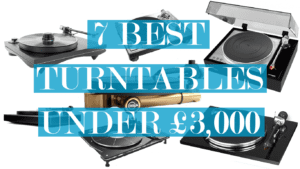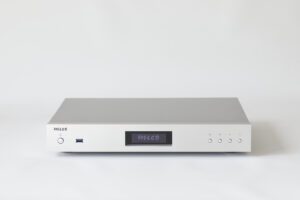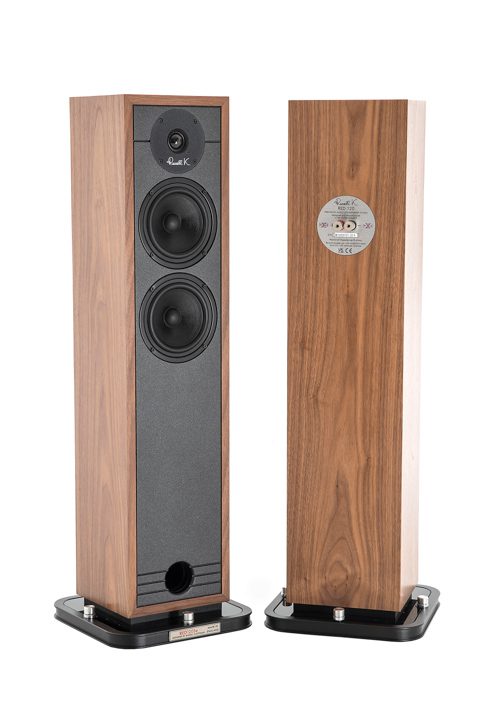
These loudspeakers got me doing something I sometimes forget to do. When I start with a new review product, I calibrate by listening to a handful of familiar tracks. But it’s easy to focus on those tracks and forget about the music on the rest of the album. On at least two occasions during the work-up for this review, I found myself listening to the entire CD rather than just the track I’d put it on for. If you compare your loudspeakers on a cost-per-unit-volume basis, I may need to help you reassess because the Russell K. RED 120Se’s aren’t priced like your typical thirty-something litre offering; but that’s OK because they don’t perform like one, either. These loudspeakers have continually reminded me I have a great music collection with some astonishing performances captured in it. Not every speaker that has graced these rooms has managed that.

There’s no shortage of well-regarded, smallish floorstanding loudspeakers at comfortably under a metre tall and maybe 20cm wide. It’s a nice size for a domestically acceptable product that promises decent all-round performance without dominating a modest-sized living space. I expect many are sold to their owners for precisely that reason. That probably explains why the majority are also keenly priced; £3,000 will buy you a very respectable, well-reviewed product from any one of a number of makers, and they’ll doubtless do an excellent job for a lot of people. So why might you, dear reader, be interested in a speaker of this size that costs twice as much as those?
Unconventional approach
Let’s assume then that, like many people, this is a size of loudspeaker that ticks a lot of boxes for you. But you’ve been there, done that, and now require more. Moving on, you may have assumed, will require moving on to something bigger.
The Russell K. approach to loudspeaker design is a little different. And it’s why you might want to read on if you’ve got this far. Manufacturers can keep development costs down by keeping to familiar recipes; conversely, being a bit different can be costly. Neither the cabinets, nor the drivers, nor yet the crossovers here are what you would call entirely conventional, but this isn’t the sort of wilfully idiosyncratic design that screams ‘owned by a single bloke’ either.
Russell K. cabinets are undamped. Tradition has it that you’ve got to damp your cabinets, or they’ll resonate and sing along. However, designer Russell Kauffman maintains that while damping may prevent cabinets from resonating along with the music, it also stores energy, releases it out of time, smearing transients and timing cues, and generally messing up the bass in particular. His solution is to manage the cabinet resonance by careful bracing and attention to detail on the internal structure of the loudspeaker so that if the cabinets do join in, they do so manageably, notably in time with the music, and crucially, they stop when the signal stops.
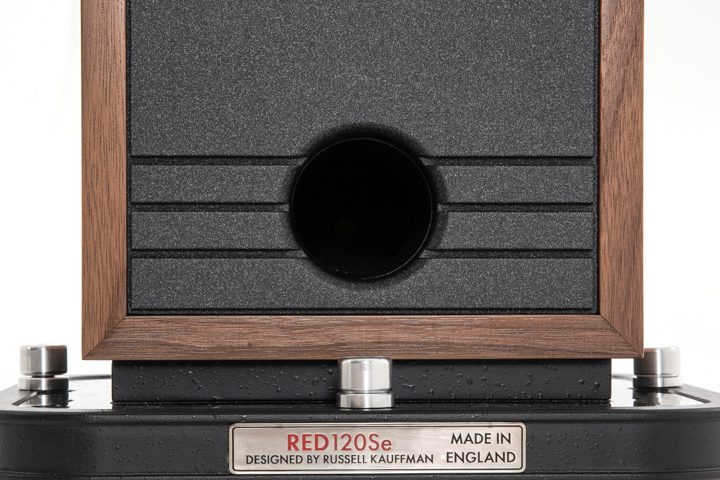
It seems to work; music I’ve thought of as complex, or dense, has revealed itself more lucidly. Take ‘Fiesta’ on the Chick Corea and Gary Burton duets album The New Crystal Silence [Concord]: you hear more deeply into the tonal differences between piano and vibraphone; the instruments remain distinct, separate and easier to discern in the busiest, most complex, or most dynamic passages. The notes start and finish when they should, and if you hear them, all the better for it. These are revealed as better, more exciting instruments, and the musicians are also clearly having a lot more fun.
Russell also uses these internal bracing shelves to manage the drivers’ loading and airflow within the cabinet. The bracing subdivides the cabinet into zones for each driver and is perforated by carefully sized and positioned apertures that impede airflow beyond a given frequency. Each driver sits within its division of the cabinet, and thanks to the way the bracing acts as a form of acoustic impedance, the bass cabinet can behave more like a sealed box; midrange energy stays mainly in the region of the midrange driver and only the lower frequencies use the whole of the larger chamber. The bass reflex system uses an internal port to tune the output, this vents into a small cavity which effectively contains any port resonances within the box, and thence it exits into the room by a small, forward-facing port. The port system has been tuned to a positively subterranean 21Hz. Because little to no midrange energy finds its way into the chamber vented by the port, there is no appreciable chuffing or other ‘noises off’ to distract the listener.
Upgraded drivers and crossovers
Compared to the regular RED 120, the Se edition comes with upgraded tweeters and reworked crossovers. The tweeter used in the RED 120 is a 25mm soft dome with a ferrite magnet system, a copper-clad aluminium voice coil with a copper Faraday ring, a second magnet, and a metal face plate feature in the Se version. Two 5” bass units deal the lower frequencies with impregnated paper cones of curved, optimised acoustic profile. The motor uses a high-power ferrite magnet, a 25mm voice coil over an aluminium former, and a Faraday ring. The paired bass drivers are connected in a two-and-a-half-way configuration, the upper driver handling bass and midrange, while the lower one handles only lower bass with a crossover which starts to roll off above 80Hz.
Russell chooses his drivers by auditioning them ‘raw’. No enclosure, no baffle, no crossover, no test tones, just a driver connected to an amplifier via its lead-out wires. Doing this highlights how many decent quality drivers, even from respected brands, exhibit audible compression and distortion. By contrast, Russell’s drivers for his loudspeakers are cleaner and more dynamic, and the Se versions are audibly improved over the stock design.
This process allows some scope for originality on the crossovers. A modified 12 dB per octave slope rolls off both tweeter and bass/mid, with only one coil in the bass path and one capacitor in the treble signal path. Tweeter attenuation is via a Zobel network with deliberately misaligned component values as opposed to the conventional L-pad resistor set-up. This avoids having resistors in the signal path, and the component values have been adjusted by ear, using speech and music. The -Se variant crosses over at a relatively low 1800Hz (the RED 120 crosses over at 2200Hz) because this is a better match with the upgraded tweeter, and there’s an additional small capacitor in parallel, which gives the crossover a faster rise time. Low bass uses an enclosed field iron core inductor for improved power handling and low energy leakage. This Se variant has a second, similar inductor in the return path, effectively creating a balanced circuit. This is said to improve bass tunefulness.
Does it work?
It would be fair to say that the RED 120Se loudspeakers concede a little to the larger RED 150 in terms of scale and weight. I used the RED 150s happily in my room for a few years, and the ‘120s are a smaller box with smaller drivers, after all. But it’s very quickly evident that the (£700 more expensive) RED 120Se is the better loudspeaker. The difference is most noticeable in large-scale orchestral music, which trades a little of the sheer size for a lot of the purpose and musicianship. Arvo Pärt, Symphony No. 4 [ECM], the second movement features some deep, dark notes from strings and bass drum, and while there’s no significant shortage of impact here, what really impresses are the instrumental textures, the contrast between xylophone and strings, or violin/violas and cello/bass. The RED 120Ses show you how the composer creates and maintains tension and the way the conductor achieves that through the performance; other speakers which go deeper have been known to gloss over this sort of thing, concentrating instead on giving you an impressive hit of bass, somewhat divorced from its musical context. Freddy Kempf, Prokofiev, Piano Concerto No. 2 [BIS, SACD] shows his exemplary articulation and tone and a real insight into the interpretation through his phrasing.
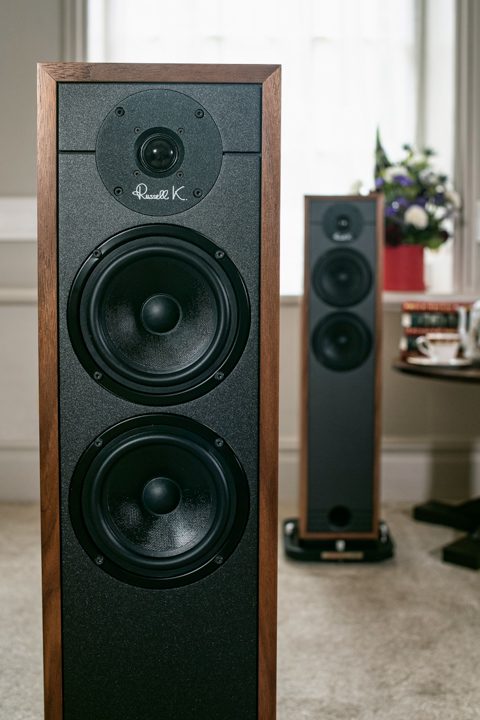
The RED 120Ses exert very good control of the different musical forces. The music remains lucid even in the busiest, most energetic passages, in a way reminiscent of a live, unamplified performance. When called upon, they will play very loud indeed without losing their composure, but they don’t do this by being buttoned-up; the music remains expressive and eloquent, the excellent sense of spatial detail intact, so the way the different orchestral forces have been set to work with each other, or with a soloist, is quickly and clearly perceived. Maybe there’s something to this notion of choosing the cleanest, most uncoloured drivers from the outset.
Scale, or proportion?
One takeaway is that bass, scale and depth are all very well but not sufficient. And perhaps more than that, what’s really important is a sense of proportion. Take ‘Log’, a piece for six pianos by Graham Fitkin [Decca]. Now six pianos in an average domestic listening room are about as appropriate as a symphony orchestra and chorus, so there needs to be some accommodation here. Me? I’ll happily trade some size and heft for an image that maintains the proportions. I want to appreciate the component elements’ relative masses, sizes and power, so I can hear deep into the performance. The RED 120Ses help me follow an individual pianist’s contribution, appreciate the timbral differences, the contributions of acoustic and electric instruments, and sense the way the centre of mass of the music shifts around in the soundscape as individual pianos take their lead. I am won over by the performance, not run over by shock and awe.
So, talking about overwhelming performances, Hugh Masekela’s ‘Stimela’ from Hope [Analogue Productions, SACD] has often hinted at colours and textures. Masekela’s vocal verges on uncanny, the voice and percussion working so tightly together for emphasis, and the evocative timbres of sax and trumpet just take this already compelling track to another level of immersiveness. It’s such a warhorse – I defy anybody to go to a hi-fi show and not hear it at least once – it’s quite easy to become inured to the power of its message through over-familiarity. The RED 120Se’s made it fresh again.
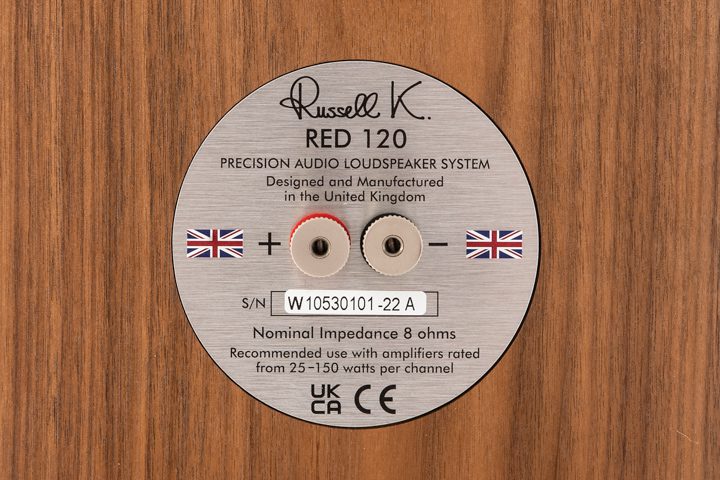
They are also very good at telling you what’s going on in the rest of your system. Change what the CD player sits on, and you hear the effect. Change what the speakers rest on, and you hear that too. Most of this review was conducted with the spikes resting on AcouPlex discs, which brought out the subtleties of phrasing in ways that made regular metal spike cups, coins, or floor protectors sound unconvincingly uncommunicative. A little attention to placement, support and isolation will pay dividends here.
So many audio touchpoints and benchmarks are hit with precision by the RED 120Se: I have talked quite a lot about timbre and colour; we also have articulation, pitch and tunefulness – Renaud Garcia-Fons’ bass is an exemplar: tight, tuneful and full of texture on ‘Berimbass’ from Arcoluz [Enja], so those claims as to improvements to the bass via the crossover tweaks ring true. And perhaps implicit in the speakers’ ability to hear deep into the mix is a facility with imaging – Patricia Barber’s quartet on Café Blue [Premonition Records, SACD] has real presence and form; and last, but arguably most important of all, we have timing – the quartet is absolutely ‘on it’ with an almost telepathic cohesiveness. These modestly-sized speakers have redefined what I expect from this size of cabinet and driver complement. That £6,000 asking price doesn’t feel like a stretch at all.
Technical specifications
- Type 2½ -way floorstanding, reflex-loaded loudspeaker with internal porting, and forward-facing reflex port. Braced, thin‑walled cabinet with no internal damping
- Driver complement 1× 25mm soft dome tweeter; 2× 5” impregnated paper cone bass/bass-mid drivers with optimised acoustic profile
- Power handling nominal 120W programme
- Crossover frequency 80Hz and 1.8kHz
- Crossover type Single-wired, phase optimised; tweeter via zobel network with misaligned component values, 12dB per octave slope; Low bass 6dB per octave via enclosed field iron core inductors
- Frequency response (in-room, usable) 25Hz–22kHz
- Impedance 4–8 Ohms nominal, 5 Ohms minimum at 50Hz and 300Hz (4 Ohms minimum at 20kHz)
- Sensitivity 86dB for 1 Watt at 1 Metre
- Dimensions (H×W×D) (including plinth) 910 × 200 × 190mm
- Weight Approx. 18 Kg each
- Finishes Real wood veneers Oak with white baffle;
Walnut with black baffle; Black Oak with black baffle - Price £5,950/pair
Manufacturer
Russell K. Ltd, Dunstable, Bedfordshire, UK
Tel: +44(0)1582 477355
Homepage – https://www.russell-k.com
Product – https://www.russell-k.com/red-120se/
Tags: FLOORSTANDING LOUDSPEAKER RED 120SE RUSSELL K. RED 120 SE
By Steve Dickinson
More articles from this authorRead Next From Review
See all
Reiki Audio SuperSwitch Master Pro + Servant Pro
- Mar 27, 2024

Melco Audio N1-S38 music server
- Mar 27, 2024

Focal Utopia 2022 headphones
- Mar 27, 2024








